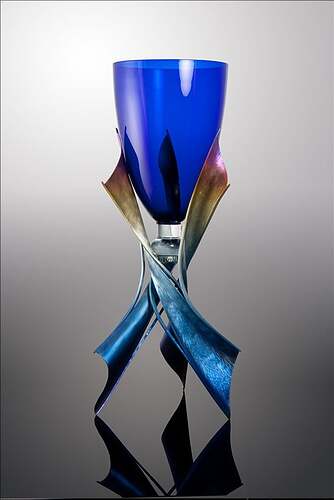Materials: Niobium, Glass
Dimensions: 4 x 4 x 12"
Communion chalice. Shellformed and welded Niobium, with cobalt blue glass.
Photo credit: Brian Meek
Brian Meek
Santa Cruz, CA. USA
My philosophy for my own art has refined itself many times over the years. It’s now down to two words: “Have fun”. I got into metalsmithing as a teenager because it opened up new challenges, and was fun in ways that I’d never imagined. I stay with it because I’ve never lost that sense of wonder in being able to make my dreams real. I’ve also found that I do my best work now when I’m having fun. This isn’t to say necessarily light or frivolous works, simply that I focus on things that interest me, and that I find challenging to work on. Essentially: projects that are fun. Why else would I do it?
I would like to camouflage this basic truth in gauzy postmodern theories of incomprehensible complexity, but in the end, the ultimate question is simply this: if my art isn’t any fun, even to me, why am I doing it?
I’ve also discovered that I like to share. I have the most fun watching people interact with my pieces. Art sitting silently in a box in the closet doesn’t really exist, or fulfill the role intended for it. I chose to go through all the complex and frequently not-fun procedures required to make a piece of my mind step out into the light of day. The payback is watching people interact with this new thing. To give the gift of magic and wonder is no small thing.
Magic and wonder are strange terrain for the child of two scientists, who programmed computers using punch-cards before he could drive. Yet that contradiction is only one of the many that I find in my art. I love ancient metalwork, and equally embrace aerospace materials and techniques. I tell my students that art shouldn’t be an inside joke, all the while busily salting my own work with inside jokes. I consider myself a romantic, yet many of the ‘jokes’ in my pieces reference such cheerful subjects as biological terrorism and the inner workings of atomic bombs. I’ve spent years trying to regularize these contradictions without finding a good answer beyond simply embracing them as the nature of my particular beast.
In the end, though, it all comes down to the simple fact that the piece made me smile when I thought it up, and I’d like to share the fun.
-Brian Meek
These containers and vessels definitely hold their place in the world of stunning art objects as well as in the world of metalsmithing.
Since the dawn of time humans have created containers to hold things that were important to them, from large vessels to hold food and harvests to intimate containers for small precious things. They might hold memories, ashes, medicine, beverage, fruit or food - but all spring from the imagination and skill of the maker. Some have specific religious functions, some are meant for everyday use. When one thinks of a vessel or container the inclination is to think of something with solid walls - yet many of these works involve the exploration of positive and negative space, and the use of negative space to help create the illusion of the wall of the vessel.
As the world’s largest jewelry related internet site, Ganoksin strives to develop exhibitions showcasing work from around the world. This exhibition was open to all metalsmiths, professional and amateur, advanced and beginner. Participants are from The Netherlands, the USA, Canada, Australia, Costa Rica, the United Kingdom, Israel, Hong Kong, Colombia, Romania, Italy, Ireland, Japan, Malaysia and Denmark. While most of the pieces are by an individual metalsmith, some are collaborations, one of three artists spanning 50 years.
In total 319 artists contributed 729 show pieces for the permanent online exhibition.
Objects in the exhibition include boxes, lockets, urns, ash containers, bowls, wine cups, reliquaries, match holders, vases, teapots, pitchers, sugar bowls, baskets, nests, pillboxes, clutches and a range of sculptural forms. A variety of techniques are showcased covering a wide range of metalsmithing techniques. Materials used include everything from gold and silver to less expensive metals. Ornamentation includes the addition of enamel, chasing and repousse’, gemstones and found objects.
The exhibition was curated by Beth Wicker, President of the North Carolina Society of Goldsmiths in the United States, and Adjunct Instructor at Northeastern Technical College in South Carolina. Director of the exhibition is Hanuman Aspler, founder of The Ganoksin Project, the world’s largest internet jewelry site.
